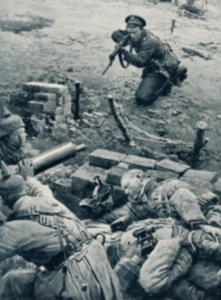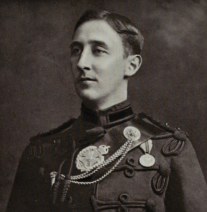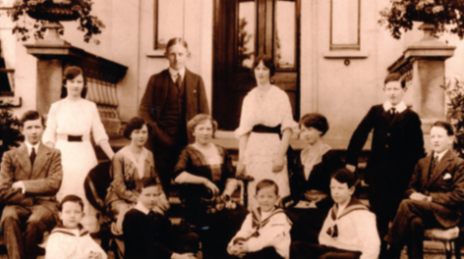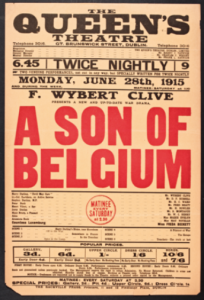World War: Ireland 1914–1918—exploring the Irish experience
Published in Issue 4 (July/August 2015), Reviews, Volume 23
By Tony Canavan

Propaganda image of Michael O’Leary, a soldier from County Cork, winning a Victoria Cross by taking out a German machine-gun nest. He may have been the inspiration for George Bernard Shaw’s play O’Flaherty VC. (NLI)
This exhibition takes us to the heart of the Irish experience in World War I. Based around information panels and interactive screens, there are also artefacts in the form of posters, pamphlets and personal papers. While it begins and ends by setting the war in its wider context, it focuses on four people who encapsulate the Irish experience: Michael O’Leary, a soldier from County Cork who won the Victoria Cross, the British military’s highest decoration; Norman Leslie, a career officer from a County Monaghan landed family who was killed in action in 1914; Mary Martin, a mother who represents the home front; and Joseph Mary Plunkett, the patriot who saw the war as an opportunity to rise against British rule.
Throughout the exhibition we are told the story of these four people, both at a personal level and how they fit in with the bigger picture. There are letters, diaries, newspaper cuttings and official records relating to them at different places throughout. This all helps to bring the conflict down to a human level and to make the experiences—few of them pleasant—real.
The section on ‘Front Line Lives’ concentrates on the horrors of trench warfare, from the mundane discomforts to gas attacks and mass slaughter. The nearby screen on ‘Modern War’ reveals the industrial scale of this conflict, with its submarines, airships, tanks and so on. In this section, too, the other side of the conflict, in the form of the medical corps and the chaplains who looked after the physical and spiritual needs of the men injured in battle, is also emphasised.

Norman Leslie, a career officer from a County Monaghan landed family, who was killed in action in 1914. (NLI)
We can see the extent to which the war affected everything. The economy and agricultural production went up a gear, recruitment rallies became a fact of life, and letters or telegrams bringing news of a fatality became a daily experience. One diary entry from Mary Martin records how recognising in the newspaper death notices the names of neighbours who had died in action brought the war home to her own street.
Even popular pastimes were infected by the war, as the poster for the play A Son of Belgium in the Queen’s Theatre, Dublin, illustrates. Related to this is the play O’Flaherty VC, written by George Bernard Shaw and possibly inspired by the real-life Michael O’Leary VC. The play explores the dilemmas facing an Irishman who becomes a British war hero. Like many others, O’Leary did not settle in Ireland after the war but re-enlisted in the army.
Of course, a significant minority opposed the war and conscription, while others saw it as the opportunity to strike a blow against Britain. This facet of the Irish experience covered a wide spectrum, from Arthur Griffith and Sinn Féin (in 1914 not yet a republican party) to the Irish Volunteers and the IRB. Roger Casement’s role in attempting to obtain German aid for a rising and even to recruit Irish prisoners-of-war into a brigade is highlighted. The latter brings Joseph Plunkett back into the story, as he too was involved in the attempt to enlist POWs into the Irish cause, and he went on to be executed for his part in the 1916 Rising.
For the war itself, the exhibition continues with sections on the different fronts on which Irishmen fought, from the Western Front to Gallipoli. The poem by Francis Ledwidge, himself killed in action, about the Irish soldiers who died at Gallipoli is particularly poignant. Although there are photographs, documents and panels galore, what really bring all this home are the interactive screens and headphones. On these you can see old newsreels of the war, listen to interviews by veterans and historians, and in one place even hear the songs and music that accompanied the Irish regiments to war. Complementing this is a large screen of ‘talking heads’, historians commenting on various aspects of the Irish experience.

Mary Martin (seated, centre, with her family) represents the home front. (NLI)
This excellent exhibition is similar in approach to that taken by many other Irish institutions in concentrating on the personal experience by following certain individuals through the conflict (see my review of the Newry and Mourne Museum exhibition in our last issue). Such an approach highlights the horror of war, the mass slaughter and its long-term effects, but it does avoid the big questions concerning World War I.

Even popular pastimes were infected by the war, as this poster for the play A Son of Belgium in the Queen’s Theatre, Dublin, illustrates. (NLI)
In the present exhibition there is little or no mention of the 36th (Ulster) Division, those northern unionists who enlisted in the British Army. They will be featured next year in the exhibition’s temporary section that focuses on the events of 100 years before, including the Battle of the Somme. In dealing with the aftermath of the war, much is made of the unpopularity of army veterans on their return to Ireland and their difficulties in finding work, but no mention is made of the fact that many joined the IRA and also the Irish Army after 1922.
Yet this is an important exhibition in bringing to light a largely shunned element of Irish history and, in concentrating on the actual experiences of those involved, is incidentally a counterpoint to those propagandists of recent decades who seek to glorify this global conflict and the sacrifice of tens of thousands of Irish lives.
Tony Canavan is editor of Books Ireland.


















